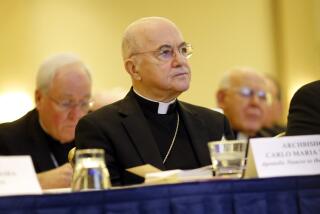Current Row on Theological Dissent Recalls Parallel 1910 Case
- Share via
NEW YORK — Once before, early in this century, a Roman Catholic scholar was removed from his post at the Catholic University of America for not adhering to an official church position--a position the church itself has since abandoned.
But without dissent, the corrected, fuller insights might never have come, according to Father Gerald P. Fogarty, a Catholic professor of religion at the University of Virginia.
Fogarty described the case in the national Catholic weekly, America, in connection with the Vatican’s recent barring of Father Charles Curran from teaching moral theology because he does not adhere to official church positions.
Wide Repercussions
The Curran case has stirred wide repercussions in scholarly circles, with some defending the Vatican in silencing teachings divergent from official positions, others saying that it gags scholarship and conscience.
Dissent, or questioning, “is essential for the theological enterprise” in pursuing a fuller grasp of truth, Fogarty wrote in the Jesuit-edited weekly.
In numerous instances through history, both Roman Catholicism and Protestantism have modified their positions as the cumulative results of such scholarly questioning and probing.
“If there is no questioning,” Fogarty said, “there can be no development of doctrine. If there is no development of doctrine, then the church and its teachings are no longer alive.”
Recounts 1910 Case
He recounted a case in 1910 involving Father Henry Poels, said to be the only Catholic University professor before Curran to have been dismissed for disagreeing with the church’s authorized position.
The specific issues differed, with Curran dissenting on some moral points, such as the church ban against contraception, while Poels dissented against the official view that Moses wrote the first five books of the Bible.
That position has long since been abandoned in most biblical scholarship, Catholic and Protestant, with the five books, the Pentateuch, seen as a compilation of various documents long after Moses’ death.
But in Poels’ time, he and others were “on the cutting edge” of a fuller understanding, Fogarty wrote, subjected to admonitions, censorship moves and other pressures to uphold the Mosaic authorship of the Pentateuch.
‘Five Books of Moses’
The church’s Council of Trent had termed those Scriptures “the five books of Moses.” To settle questioning, cardinals of a Pontifical Biblical Commission set up in 1903 ruled that Moses was “substantially” the author.
Through an interpreter, Poels spoke with Pope Pius X about difficulties with the decision, and was told through an intermediary not to contravene it and to show “respect to authority,” Fogarty related.
Back at Catholic University, Poels underwent various charges and inquiries into his concepts, including an order from Pius X to resign because his teaching was “was not in conformity with the magisterium of the church.” The magisterium is the authentic teaching authority of the church’s hierarchy--bishops, cardinals and the Pope.
The Vatican’s secretary of state, Cardinal Raffaele Merry del Val, entered the picture, Fogarty related, presenting Poels with an oath of conformity, which he declined to sign, and accusing him of disobeying the Pope.
‘Destroyed Scholarship’
By refusing to sign the oath, Poels “was maintaining that a Vatican office could not force him to abandon his scholarly findings,” Fogarty wrote, and by insisting that “he take the oath, the hierarchy virtually destroyed biblical scholarship in the United States for the next generation.”
The account said that the matter dragged on, with labyrinthine shifts back and forth, the Pope at one point conceding that he had mixed up Poels’ case with someone else. But at Cardinal del Val’s demand, the university finally dismissed Poels in 1910.
Fogarty noted that the case came in the aftermath of papal condemnation in 1899 of “Americanism” for its ideas of religious liberty, about which the American hierarchy was divided at the time.
Later, in the early 20th Century, the Pope launched a battle against “modernism,” calling for establishment in each diocese of “vigilance committees” to report any deviations directly to the Vatican.
‘Increased Romanization’
“It was a period of increased Romanization of the hierarchy,” Fogarty said, bypassing U.S. bishops as part of the teaching magisterium, allowing “their authority to be taken from them.”
He said that “from the case of Father Poels and others, there developed a blurring of the distinctions between infallible and non-infallible statments of the magisterium,” between it and statements of Vatican offices.
As a result, “theology became the mere repetition of such statements, and development of doctrine an impossibility,” Fogarty wrote of that earlier period.
Curran, in the current case, also charges a Vatican blurring of distinctions between fundamental, infallible doctrines and ordinary non-infallible teachings, emphasizing that his dissents involve only the latter.
‘Blurred Distinction’
Back in the previous period, Fogarty said, “some theologians and bishops had further blurred the distinction between solemn definitions, encyclicals and apostolic letters intended for particular situations” and two U.S. archbishops maintained that the condemnation of Americanism was infallible.
That former papal view, however, was decidedly rejected by the Second Vatican Council of 1962-65, which formally embraced religious liberty--largely at the influence of a once-silenced U.S. theologian, John Courtney Murray.
More to Read
Sign up for Essential California
The most important California stories and recommendations in your inbox every morning.
You may occasionally receive promotional content from the Los Angeles Times.













